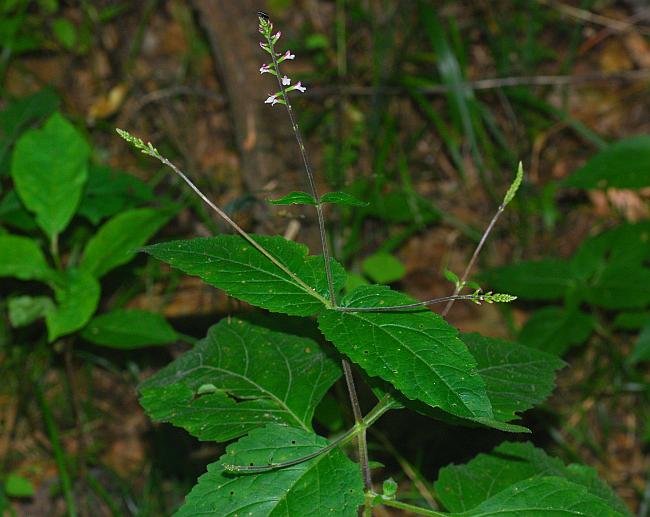Phryma leptostachya L.
American Lopseed

Native
CC = 2
CW = 5
MOC = 67
© SRTurner
Phryma leptostachya L.American Lopseed | |
 |
Native CC = 2 CW = 5 MOC = 67 |
© SRTurner |
|
Family - Phrymaceae Habit - Perennial forb with fibrous roots. Stem - Strongly ascending to erect, to 1 m, usually solitary, unbranched or few-branched near the tip, 4-angled, moderately to densely pubescent with short hairs, sometimes becoming nearly glabrous with age.
Leaves - Opposite, the lower leaves long-petiolate, the petioles progressively shorter toward the stem tip, the uppermost leaves sometimes sessile. Leaf blades 3-16 cm long, ovate, truncate to broadly tapered at the base, angled or tapered to a pointed tip, the margins scalloped or bluntly toothed (often coarsely or irregularly so), the surfaces sparsely to moderately short-hairy or glabrous.
Inflorescences - Terminal and sometimes also axillary from the upper leaves, interrupted, long-stalked spikelike racemes of numerous opposite flowers, each subtended by an inconspicuous, linear bract 2-3 mm long and a pair of very short, toothlike bractlets on the upper side, the stalks 0.5-0.8 mm long at flowering.
Flowers - Flowers ascending in bud, spreading at flowering, strongly reflexed (appressed to the inflorescence axis) at fruiting, decussate along axis. Calyces 5-8 mm long, becoming somewhat hardened at fruiting, glabrous or minutely hairy, 5-lobed, bilabiate, cylindric. Corollas zygomorphic, 6-10 mm long, the upper lip 1.5-2.0 mm long, arched outward, notched at the tip, lavender to pale purple or rarely reddish purple, the lower lip 2.5-3.5 mm long, with the lateral lobes about equal to or somewhat wider than the middle lobe, white, rarely reddish-tinged, bearded. Ovaries appearing 1-carpellate, containing 1 ovule.
Fruits - Achenes, 3-4 mm long, narrowly ellipsoid, glabrous
Flowering - June - September. Habitat - Mesic and bottomland forests, streambanks. Origin - Native to the U.S. Lookalikes - None. Other info. - This species is not highly conspicuous. The flowers are small and easily missed, but also interesting and nicely colored up close. The plant grows across Missouri, as well as the eastern half of the U.S. and Canada. Field identification is easy, since nothing else in the state looks like it. The flowers are spreading and decussate (alternating directions by 90 degrees at each node) along the stem, and become strongly deflexed in fruit. Look for this plant in moist, shaded forest environments. Photographs taken at Busch Wildlife Area, St. Charles County, MO, 6-28-2009, Faust County Park, St. Louis County, MO, 6-28-2010, Weldon Spring Conservation Area, St. Charles County, MO, 6-27-2009, 6-21-2012 and 7-3-2013, Young Conservation Area, Jefferson County, MO, 6-24-2019, and Glassberg Conservation Area, Jefferson County, MO, 6-28-2023 (SRTurner). |